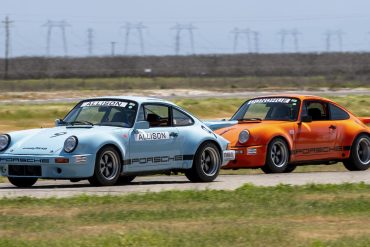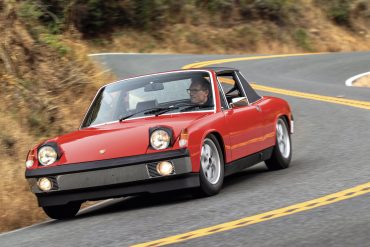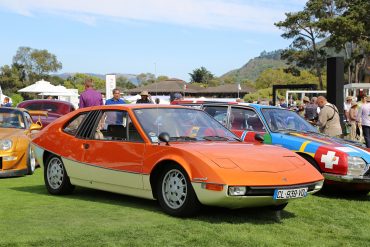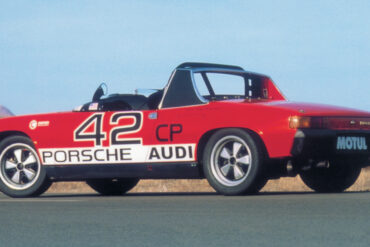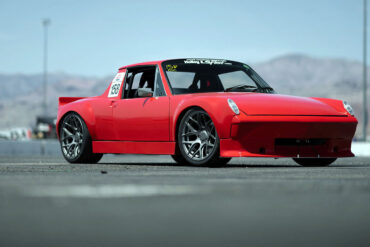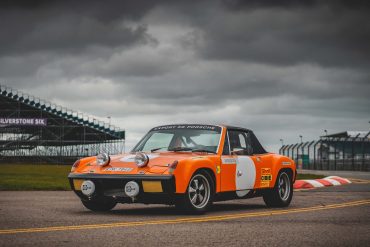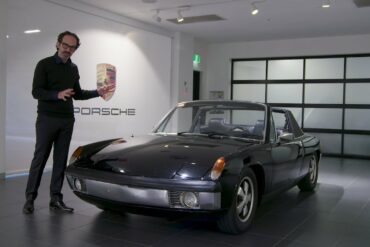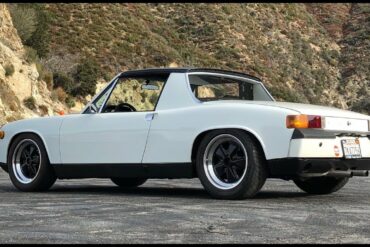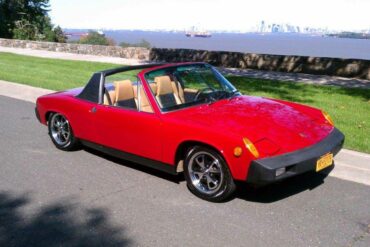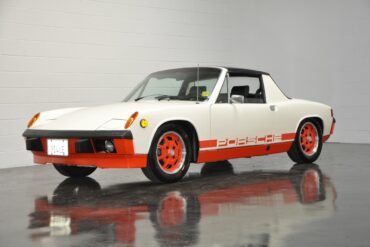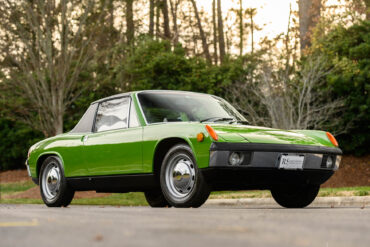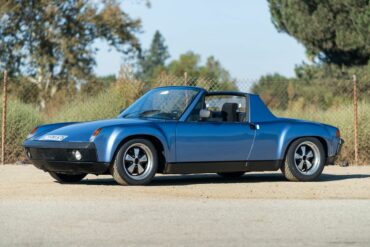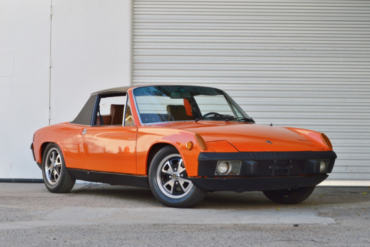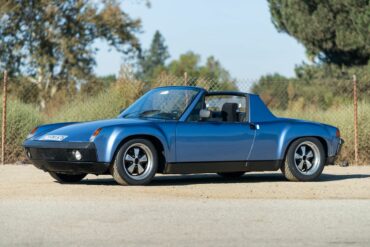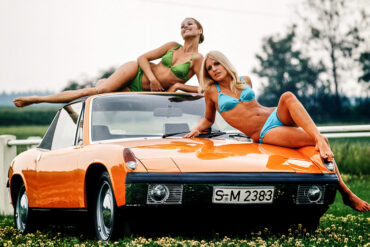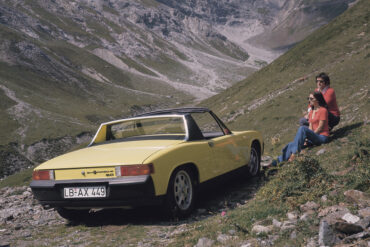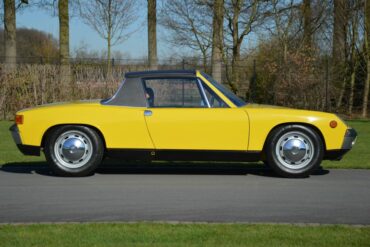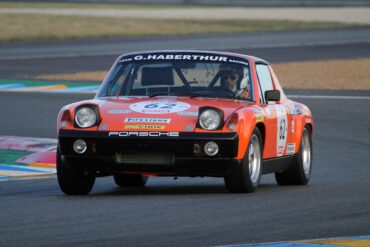Based on the Porsche 914, this special-edition model was a commemorative release that celebrated one of the most dominant Porsche...
Porsche 914
The Porsche 914 was a joint development between Porsche and Volkswagen and was the new Porsche entry-level model as of model year 1970.The two-seater, also known as the “VW Porsche”, was a mid-engine Sports Car. Striking design features included the very long wheelbase for the vehicle length, short overhangs, the removable roof centre panel made from glass fiber-reinforced plastic as well as the wide safety bar. The 914 also featured pop-up headlights. At the time of its launch, the 914 was available with two engines. 914: 1.7-liter flat-four engine with 80 hp from Volkswagen and the 914/6: 2.0-liter flat-six engine with 110 hp from the Porsche 911 T. These were followed by a 2.0-liter four-cylinder engine with 100 hp based on the 1.7-liter engine in model year 1973 and a 1.8-liter four-cylinder engine with 85 hp in model year 1974. See all of our Porsche 914 Research.
The night before… One night in 1999, under cover of darkness, an entire terminal building was lifted onto flatbed trucks...
The Porsche 914, once known as Porsche’s humble entry-level model, was an affordable, slow, and often overlooked car from the...
They might have access to original bodywork methods, tools, parts and the company archive. But the most valuable thing is...
The 15th Targa California rally recently concluded with most drivers logging 1,000+ miles over the roads “less traveled” of California’s...
In a bold move away from the usual 911 restorations, 9WERKS TV brings you an exclusive look at the latest...
What makes the Porsche brand so legendary? What inspires people to keep it young and full of life 75 years...
The Porsche 914 often stands as one of the most underrated models in the manufacturer’s storied history. Lacking the striking...
On display at the 20th annual The Quail, A Motorsports Gathering, in Carmel Valley was a strange little car that...
The 9th annual Werks Reunion Monterey, held by the Porsche Club of America, took place for the second year in...
For better, and sometimes for worse, corporate culture and business strategy have historically played a significant role in motorsport. Over...
Porsche 914 with V8 transplant becomes a father/son love affair When Porsche introduced the 914 back in 1969, the automaker’s...
Only two of these prototype 914-8 supercars were ever built making them some of the rarest Porsches ever built. The...
Let’s face it, the Porsche 914 was not the most iconic of sports cars in the storied history of the...
The 914/6 was the Porsche-engined version of the 914, the joint venture sports car designed by Porsche and built at...
Porsche 914-6 Is An Absolute Classic After expressing an interest in racing, saying it “looked like fun,” Mr. Jack Griffin...
Introducing the Porsche 914 PCM Sportscar & Classic Specialist Ben Musu introduces the mid-engine, two seater sports car in this...
Porsche 914/6 Targa Racing Cars Tribute This video is dedicated to some Porsche 914/6 Targa in a racing version that...
1970 Porsche 914-6 Review We go for a drive in the 1970 Porsche 914-6...
1970 Porsche 914/6 – The Mid-Engine Flat 6 You Need to Drive The Porsche 914-6 may only have 110hp but...
1974 Porsche 914-6 GT Jay Leno Review Hans Lapine and Eric Shea stop by the garage to talk 914 history...
1973 Porsche 914/6 Video Review This 1973 Porsche 914-6 was the owner, Marco’s car when he was in high school,...
The Porsche 914-6 GT was a race car built by Porsche, based on the 914 model with a 6-cylinder engine and GT package. The 914-6 GT was a race configured version of the 914-6. The factory offered the GT option, which was distinguishable by its box-like steel fender flares. It quickly became known as the 914-6 GT and was raced employing different engine configurations. This included the 'T' specification, which was a basic 911 engine. Another popular configuration was to use a converted Carrera 6 engine.
Porsche only built 2 914/8s. The first was a development mule that Piëch used to prove the concept of a 914/8. The second was built for Ferry Porsche as a birthday present. Both are very unique 914s still owned by Porsche and regularly shown at the museum in Stuttgart. They had a 300 HP 3.0L 908 engine and a 916 transmission, and was never registered for the street. This was a test bed and a prototype.
For 1974 a 1.8-liter engine replaced the 1.7 and had a new type of electronic fuel injection called AFC (air flow control), or ‘L’ Jetronic. This same basic injection was used on 911s in the late-’80s. Unfortunately, due to emissions regulations, the 1.8 made just 76 hp, less than the smaller engine it replaced. The standard steel wheels were changed to 5.5-inch wide VW units. Rubber bumper guards now adorned the rear and the headlight surrounds were changed from white to black plastic. US cars got the infamous ignition seat-belt interlock buzzer. This was also the year of the limited edition series.
1974-1975 Porsche 914 1.8L Specifications Engine 1.8 L Flat 4 Induction Normally-aspirated Cooling Air/oil-cooled Valvetrain Pushrod-actuated overhead valves Injection Port...
Porsche produced two limited edition 914 models: the Creamsicle and Bumblebee, the latter created to celebrate the Porsche's domination of the Can-Am series with the Type 917. The Bumblebee was finished in black with contrasting Summer Yellow lower sections. Many otherwise optional items were standard on these limited edition models, including driving lights, dual horns, a leather covered steering wheel, and a centre console with clock etc. 500 of each type were manufactured.
Porsche 914 Model Numbers Standard Equipment = Basic Equipment (no appearance or performance group) Appearance Group = Comfort Equipment...
Porsche 914 Paint Color Options & Samples This post outlines all the color options for the Porsche 914 over its...
Porsche 914/4 Vehicle Type Codes Year Model Engine Code Displ (cc) HP DIN @rpm Bore (mm) Stroke (mm) Compression Fuel...
Porsche 914 Tune Up Specifications Valve Clearance with engine cold Description 1700cc 4-Cylinder 1800cc 4-Cylinder 2000cc 4-Cylinder 2000cc 6-Cylinder Intake...
Porsche 914 Torque Specifications Engine Description lb f ft. kg f m Oil Drain Plug 16 2.2 Retaining nut for...
Porsche 914 Lubricants & Fuel Specifications Description Temperature Range Recommended Type Capacity Engine Oil Below 5F (-15C) SAE 10W, 10W-30...
Porsche 914/4 Vehicle Type Codes Year Model Liters Engine Code Displacement (cc) HP DIN @rpm Bore (mm) Stroke (mm) Compression...
Porsche 914 VIN, Engine, Transmission & Chassis Numbers Our reader already know we have an in-depth VIN decoder for Porsche...
Porsche 914 Production Volumes Porsche 914 Model Totals Porsche 914 Production by Year & Model...
1970 – 1972 Porsche 914/6 2.0L Specifications Price $ $6,099 USD Engine 2.0 L mid-mounted flat-6 Valvetrain OHC Displacement 1991...
1973 – 1976 Porsche 914 2.0L Specifications engine Air-Cooled Flat-4 displacement 1971 cc / 120.3 in³ compression 8.0:1 power...
1970 – 1973 Porsche 914 1.7L Specifications Price $ $3,595 USD Engine 1.7 L mid-mounted flat-4 Valvetrain OHV Fuel feeding...
Transmission Codes for the Porsche 914 (All Years) 300.01 914/6 manual 5-speed 300.05 914/6 sportomatic 4-speed 300.11 914/4 manual 5-speed...
German pricelist for 1974 model year Porsche 914 1.8-litre, 63 kW 2.0-litre, 74 kW VW-Porsche 914-4 DM 13.990 DM 14.990...
Porsche 914 History & Story Porsche needed an entry-level car to replace the 912 and Volkswagen needed a sports car...
1970 – 1973 Porsche 914 Specifications price $ $3,595 USD engine Flat 4 valvetrain OHV displacement 1679 cc / 102.5...
Porsche 914 Sales Brochure We go back to 1969 to find a number of Porsche sales brochures for the diminutive...
Porsche 914 Spare Parts Catalogs (1970 – 1976 Model Year) These official Porsche PET Diagrams and codes for the Porsche...
Porsche Option Codes – Porsche 914 Looking to decode your Porsche 914 option codes? Want to know what those codes...
Obviously these two attractive models from the lingerie manufacturer Triumph (München) like this Porsche 914/6 – Rutesheim Athletics Club, Baden-Württemberg,...
Quick Test Drive of the PORSCHE 914/6 from 1971 This is not an ordinary 914. It is the version with the...
This came in 1973, when the fuel-injected variant of Volkswagen’s air-cooled Type 4 engine was dropped in behind the two seats, staying there through 1976, when series production ended. (The engine continued on in the 912E, which succeeded the 914 as Porsche’s entry-level car.) The short-stroke, overhead-valve powerplant displaced 2.0 liters (1971 cc) and made its 100 hp at 5000 rpm, whereas the six had made 110 hp at 5800 rpm. Yet the four matched the six’s torque output of 118 lb-ft, achieving this figure at 3500 rpm instead of 4200 rpm. And it was lighter in weight.
The Porsche 914 was first shown at the 1969 Frankfurt Auto Show was, as intended, a true conglomeration. The front suspension was largely derived from the 911 with some VW components, and the interior was a blend of both companies' parts bins. The initial engine offering was Volkswagen's 80-hp fuel-injected 1.7 liter flat four, while the 914/6 had a twin-carburetor 2.0-liter Porsche flat six tuned for 125 hp.
The standard 914 was powered by Volkswagen’s horizontal four-cylinder engine, producing a power output of 80 hp. Even with the lightweight Porsche body, acceleration suffered. The solution to this was to offer a second version: the 914/6, powered by a six-cylinder engine, total power output exceeded 100 hp. Unfortunately, this came with an extra cost– the 914/6 was nearly as expensive as a standard 911.






